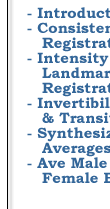
 |
|||||
 |
|||||
Next: Image Registration Up: Transformation Properties Previous: Invertibility property
Transitivity property
Image registration algorithms that have a difficult time producing inverse consistent transformations have an even harder time producing transformations that satisfy the transitivity property. In this paper we investigate how an algorithm that reduces the inverse consistency error compared to another also reduces the transitivity error.
A set of image transformations ![]() is said to have the transitivity property if
is said to have the transitivity property if
![]() or equivalently if
or equivalently if
![]() for all
for all
![]() and
and
![]() .
.
These transitivity relationships are illustrated in Fig. 1.
Assume that the points ![]() ,
, ![]() , and
, and ![]() correspond to the same landmark in images
correspond to the same landmark in images ![]() ,
, ![]() , and
, and ![]() , respectively. Assume that the set of transformations
, respectively. Assume that the set of transformations
![]() has the invertibility
and transitivity properties such that
has the invertibility
and transitivity properties such that
The average transitivity error is defined as
and the maximum transitivity error is defined as
Eqs. 3 and 4 are discretized for implementation.
Figure 2 demonstrates an advantage
of producing transformations that satisfy the transitivity property. The
left panels shows that the minimum number of invertible transformations
required to map information from one coordinate system to another is ![]() where
where ![]() is the number of image volumes. The correspondence between any two
coordinate systems is determined explicitly by one of the displayed transformations
or indirectly by concatenating two of the transformations. For example,
a point
is the number of image volumes. The correspondence between any two
coordinate systems is determined explicitly by one of the displayed transformations
or indirectly by concatenating two of the transformations. For example,
a point ![]() in coordinate system B is mapped to
in coordinate system B is mapped to ![]() in coordinate system C by the mapping
in coordinate system C by the mapping
![]() , etc.
, etc.
|
Figure 2 demonstrates that
it is advantageous to design pairwise registration algorithms rather than
N-wise registration algorithms that satisfy the transitivity property.
The first advantage is that a pairwise algorithm only needs to compute
![]() pairwise transformations as opposed to
pairwise transformations as opposed to ![]() pairwise transformations. This reduces computation time and
computer storage requirements by a factor of
pairwise transformations. This reduces computation time and
computer storage requirements by a factor of ![]() factorial. Another advantage is that a pairwise algorithm only
requires one additional set of pairwise transformations to be computed
to add a new data set to the population. An N-wise registration algorithm
requires that all of the transformations to be recomputed to produce a
set of transformations with the transitivity property.
factorial. Another advantage is that a pairwise algorithm only
requires one additional set of pairwise transformations to be computed
to add a new data set to the population. An N-wise registration algorithm
requires that all of the transformations to be recomputed to produce a
set of transformations with the transitivity property.
In general, pairwise image registration algorithms do not produce transformations
that have the transitivity property. The degree of transitivity can be
evaluated by measuring the difference between the identity mapping and
the composition the transformations from image ![]() -to-
-to-![]() ,
, ![]() -to-
-to-![]() , and
, and ![]() -to-
-to-![]() .
.
Next: Image Registration Up: Transformation Properties Previous: Invertibility property Gary E. Christensen 2002-07-04
Copyright © 2002 • The University of Iowa. All rights reserved.
Iowa City, Iowa 52242
Questions or Comments: gary-christensen@uiowa.edu

